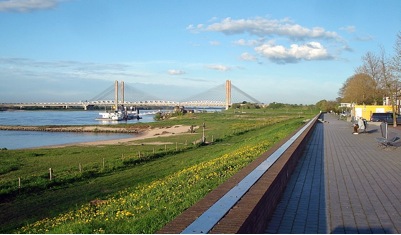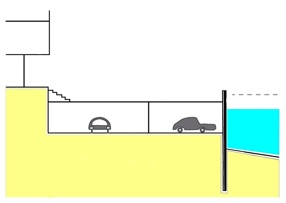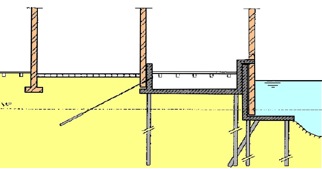Multifunctional Flood Defences
Multifunctional flood defences are structures that are intended to protect land against being covered by water and that are meanwhile used for other purposes, such as transport, housing, shipping, agriculture, nature and recreation. A dike with a road on top, for instance, is a multifunctional flood defence. Houses with water-retaining walls, or parking garages in dunes are other examples. To be able to function as a flood defence, these structures have to be part of an entire flood defence system, like the 'dike rings' in the Netherlands. This means that the maintenance, inspection, control and the formalisation of acceptable safety levels have to be organised.
The combination of flood protection with other functions becomes an interesting option, if necessary improvement of existing flood defences conflicts with other functions, like housing. In addition, multifunctional flood defences can become a relevant option for ongoing urbanisation in built-on areas, requiring more space. Next to spatial optimisation, dividing the costs between several parties could be an attractive advantage of these combined structures. Governance issues related to multifunctional flood defences, however, are very delicate because of possible conflicts in responsibilities.
A research programme of the Dutch Technology Foundation STW has studied the integrated and sustainable design of multifunctional flood defences. The programme started in 2011 and was almost completed in 2017. Eleven researchers and four PostDocs studied the behaviour of the multifunctional flood defences during extreme storms. New principles of risk assessment methods were developed and technology for multifunctional and flexible flood defences has been integrated into the development of urban and rural landscapes. Furthermore, new governance and asset management principles were developed for multifunctional flood defences in the design and management phase. New physical and safety knowledge was integrated into the design of multifunctional flood defences.
Involved research institutes are: Delft University of Technology, Wageningen University and University of Twente. Potential users exist of regional authorities (water boards a.o.), national authorities (delta programme and ministries), research institutes (Deltares a.o.) and companies (Dura Vermeer, Arcadis, HKV).
Within the Department of Hydraulic Engineering five researchers were involved in the programme: Xuexue Chen (wave overtopping and loads on buildings), Kathryn Roscoe (probabilistic models), Flora Anvarifar (uncertainty, adaptability and robustness), Guy Dupuits (optimal and robust design) and Mark Voorendt (design principles).
Their PhD-theses can be found at the repository.
More information about the research program can be found at www.flooddefences.org.

Multifunctional quay in Zaltbommel

Cross section of a combined quay and parking garage in Zwijndrecht

Cross section of a house in Dordrecht, combined with a flood protection function